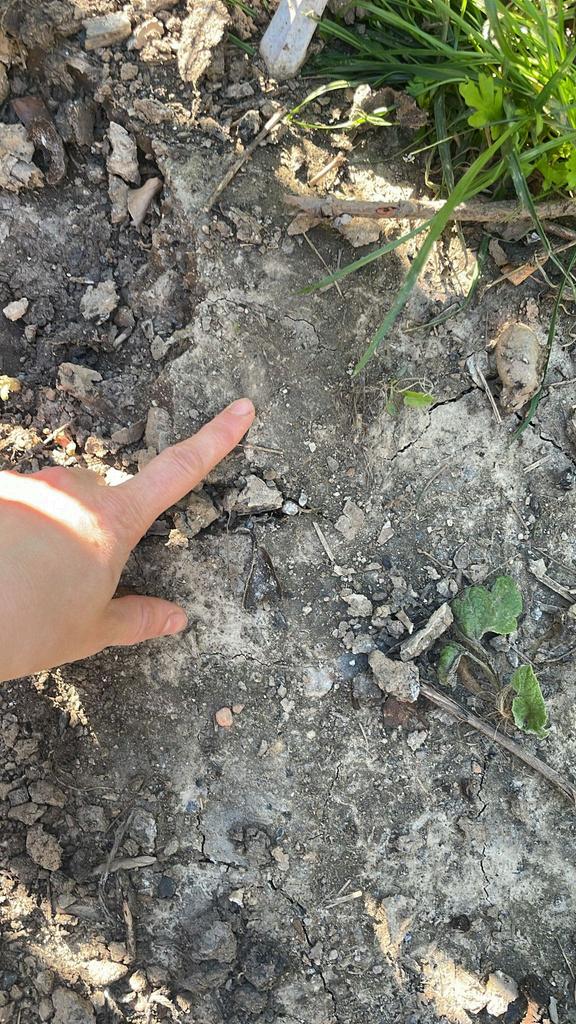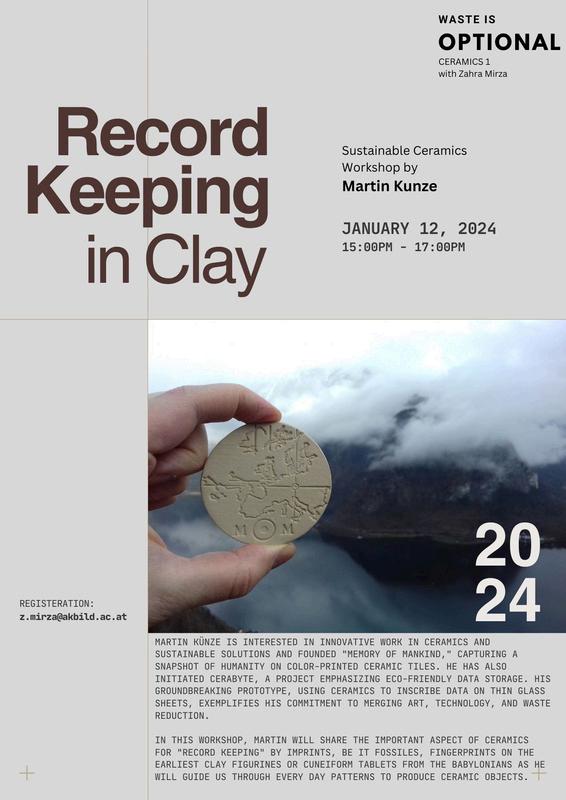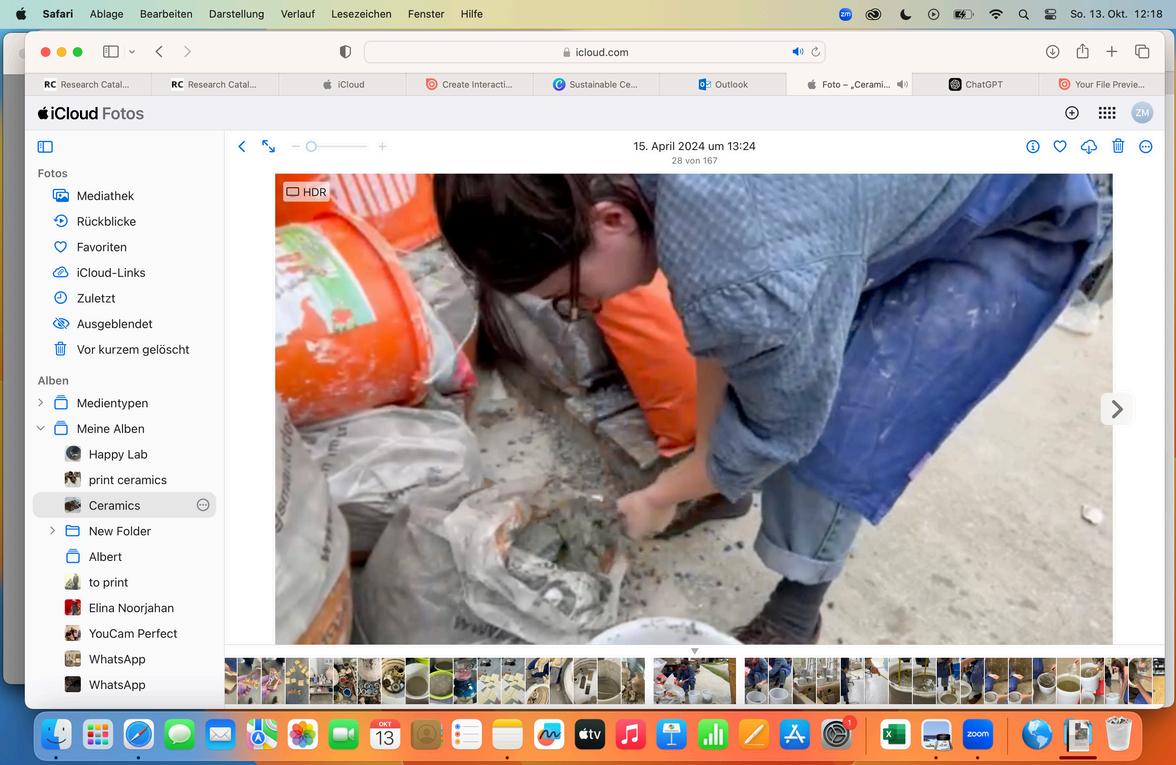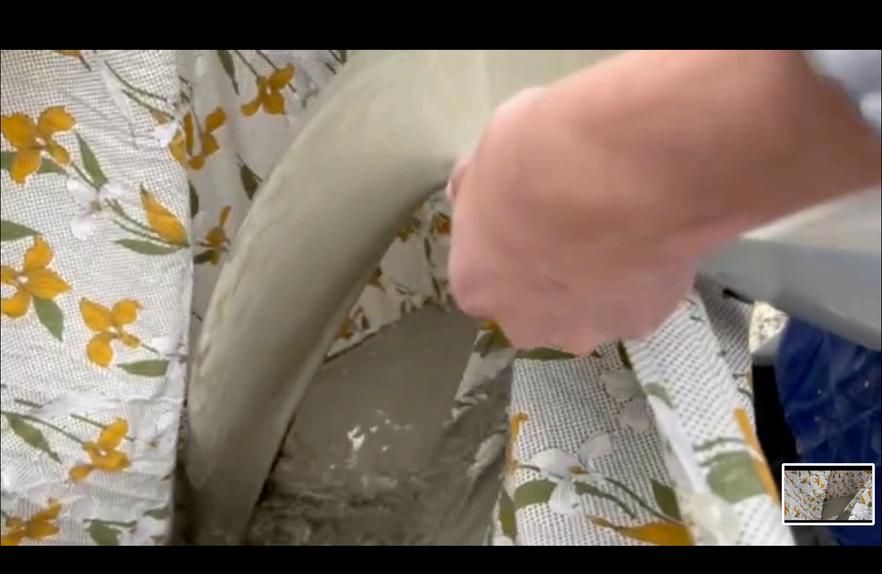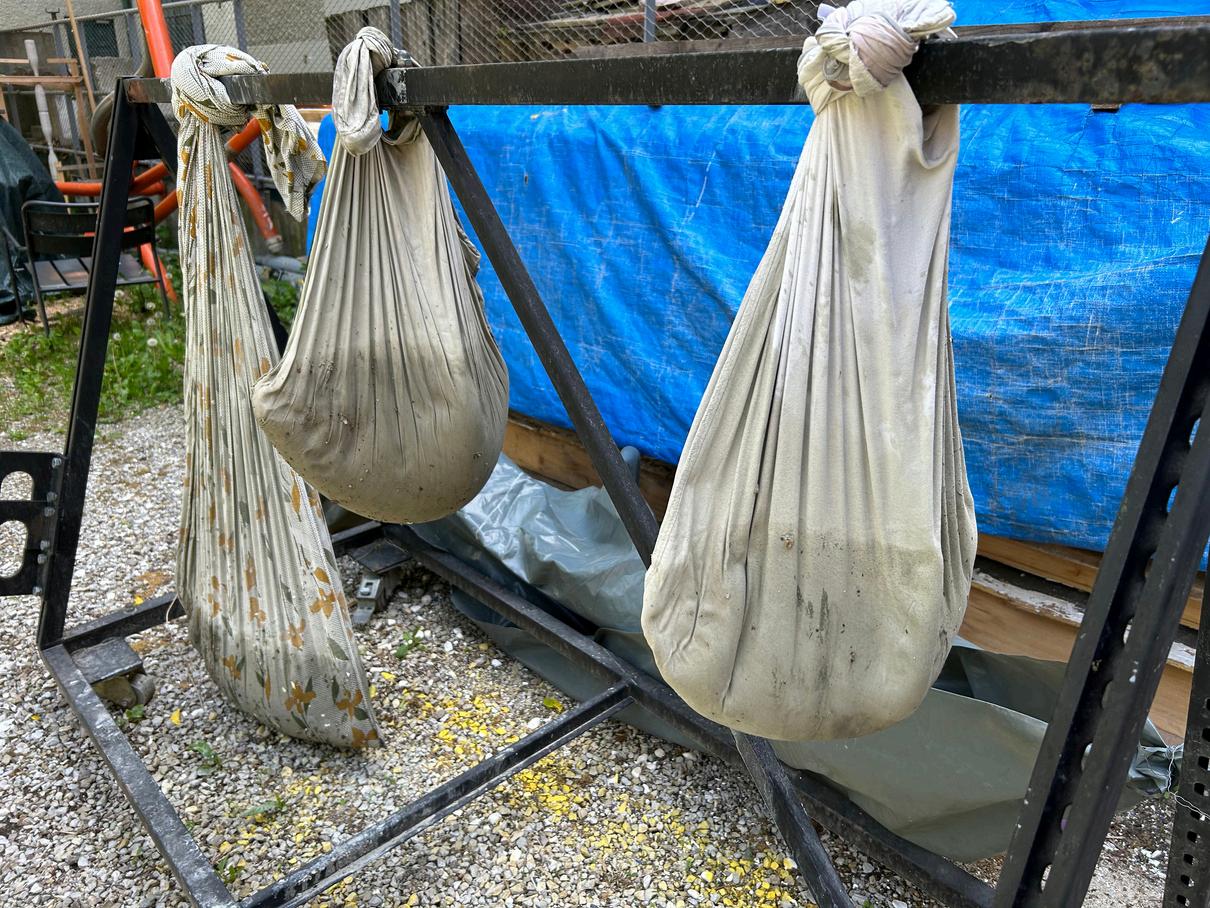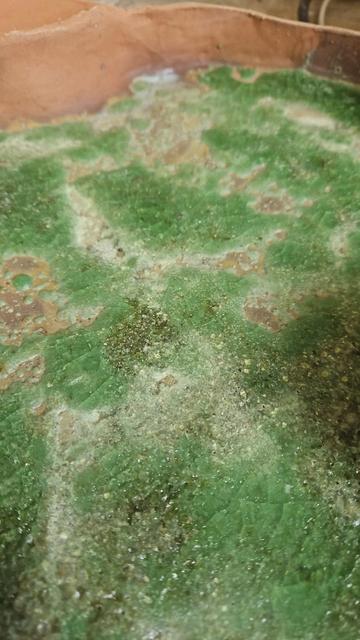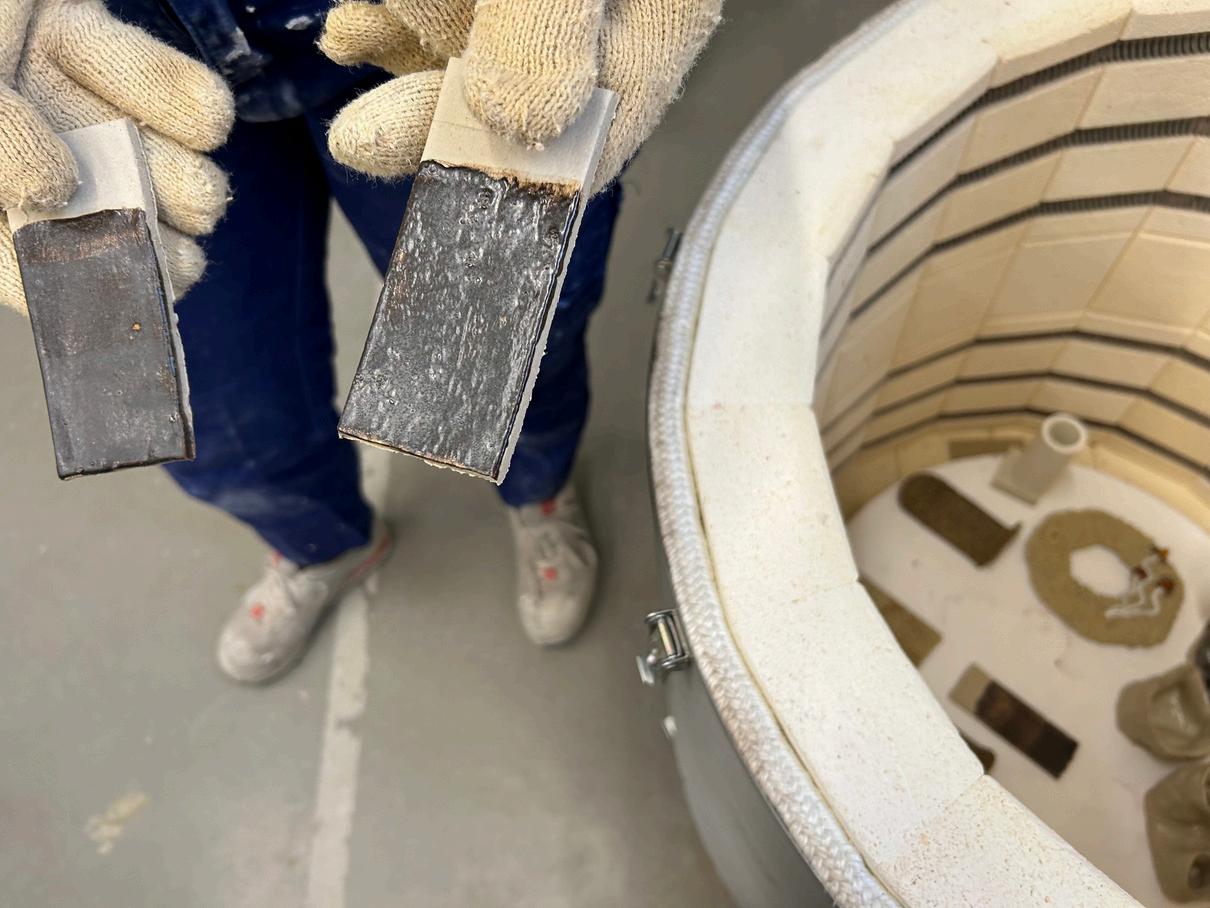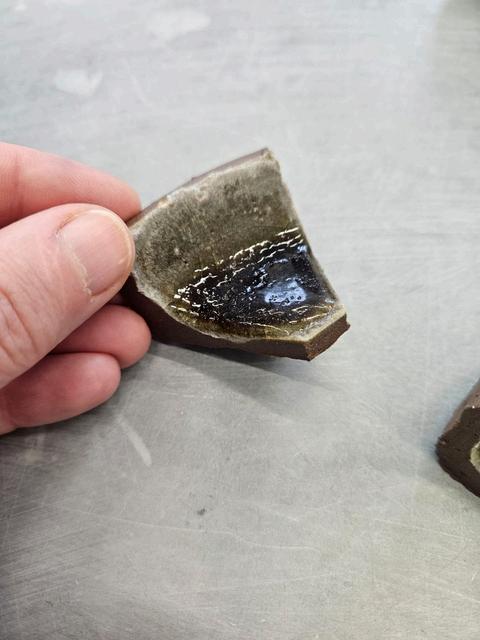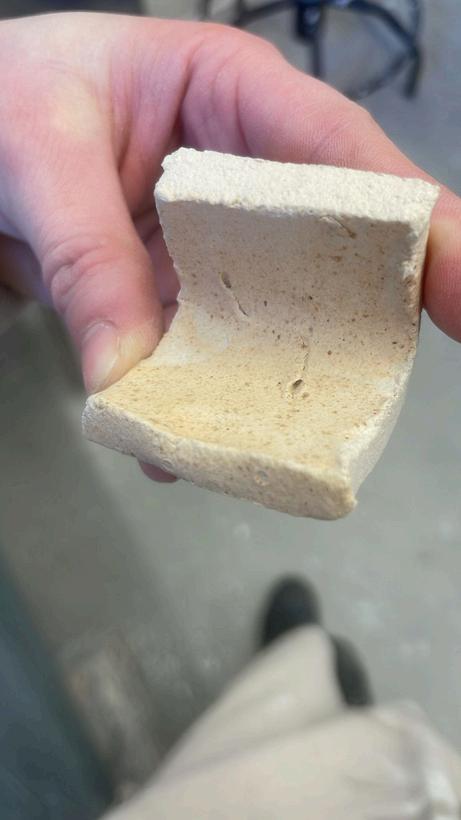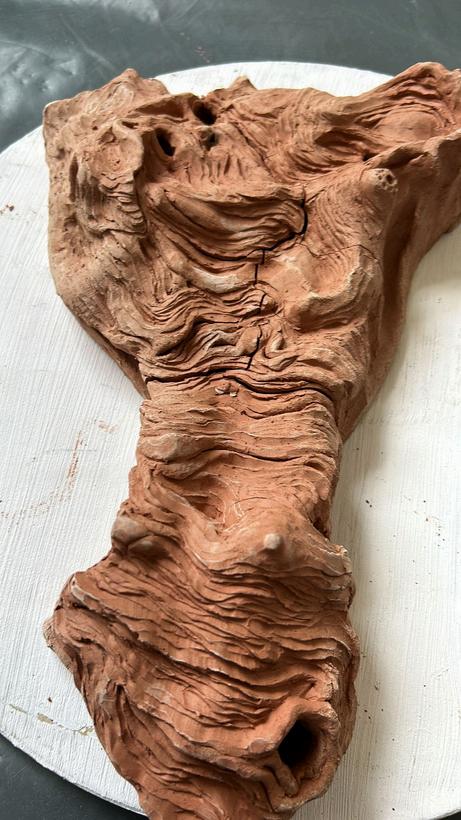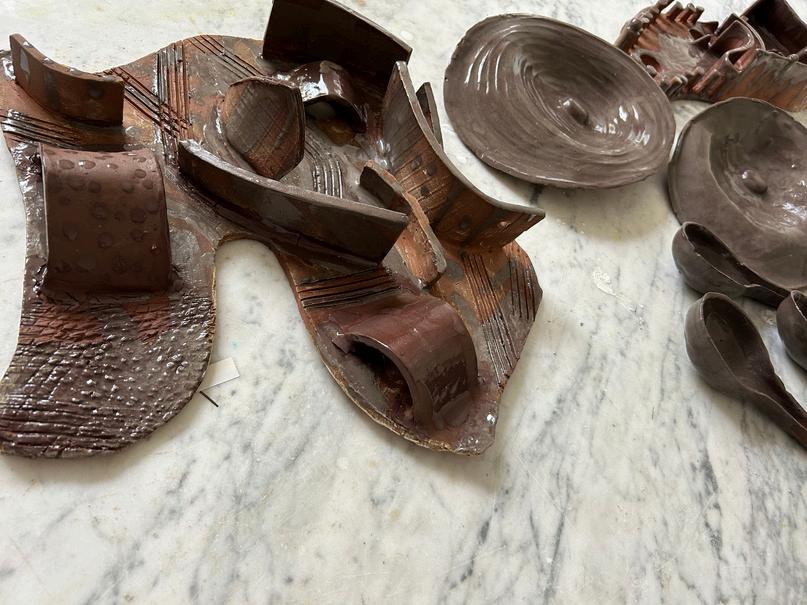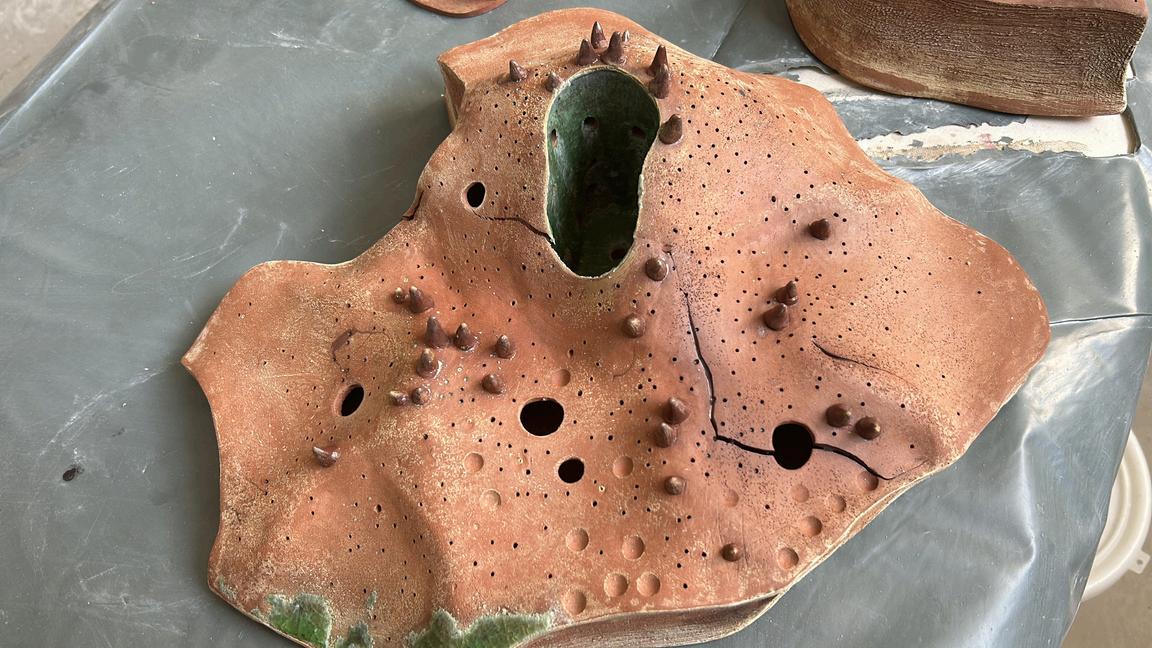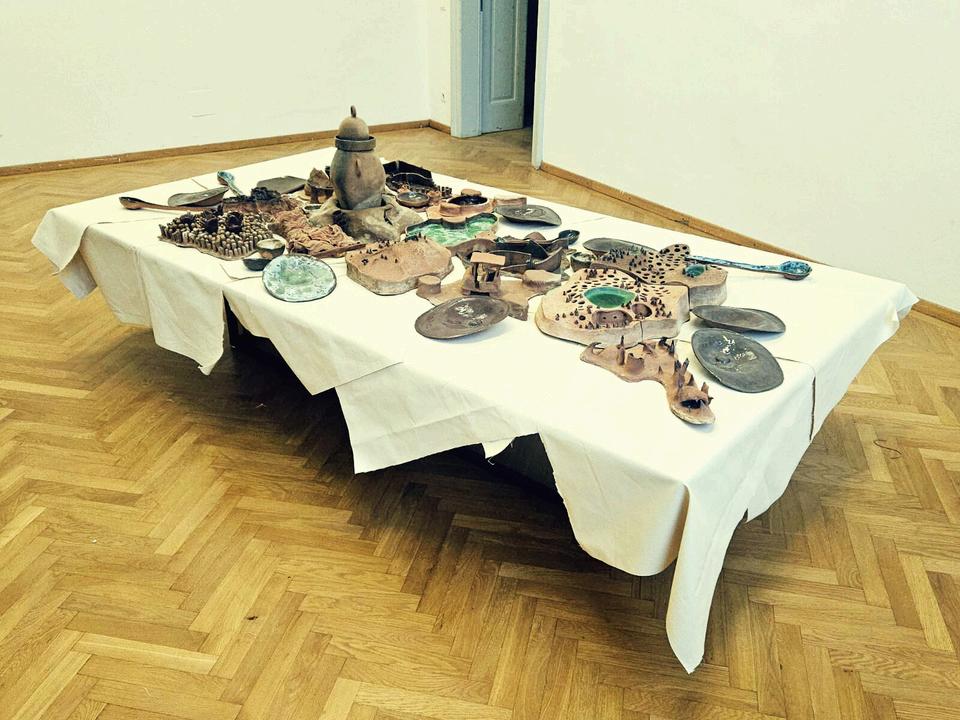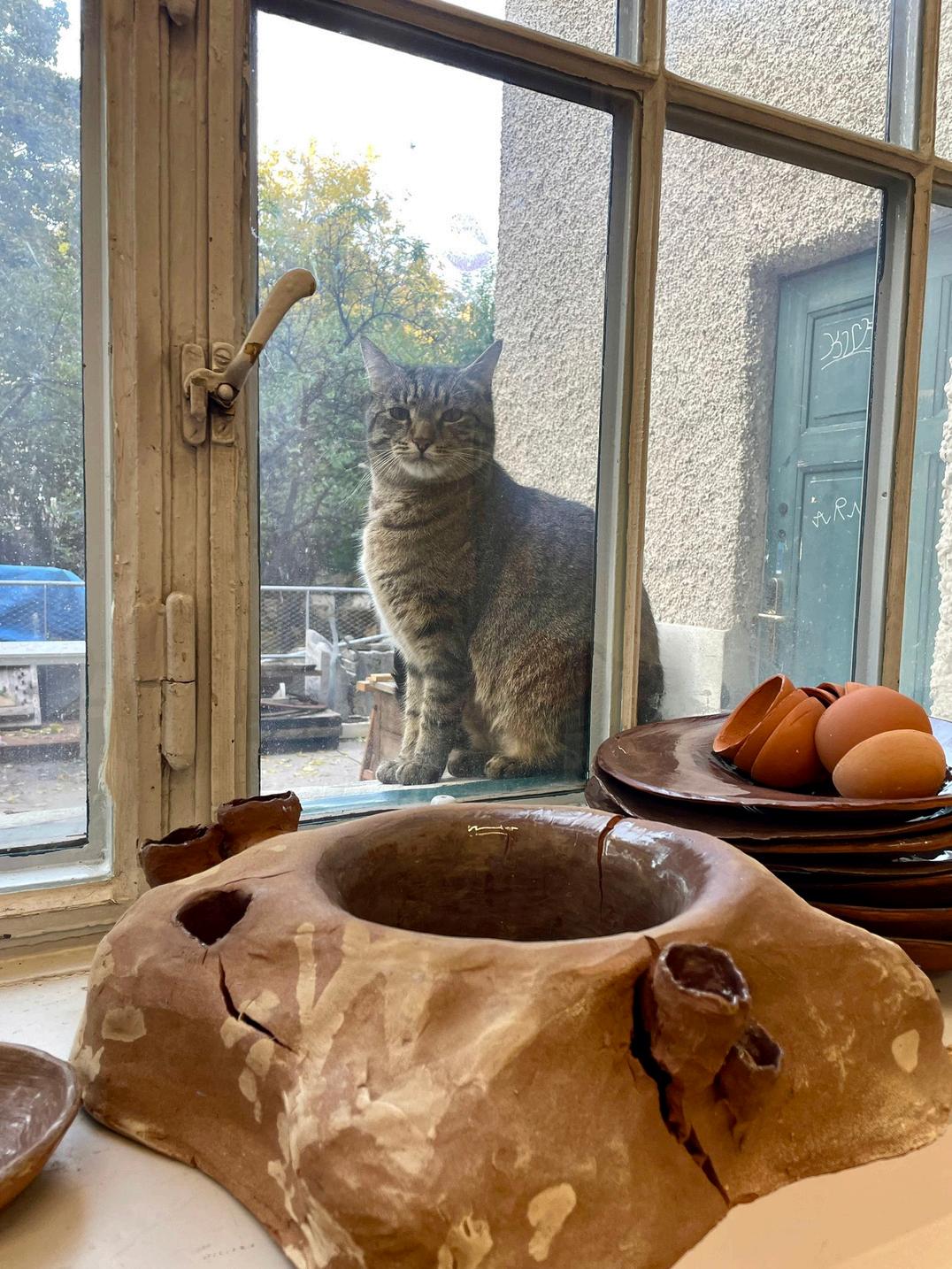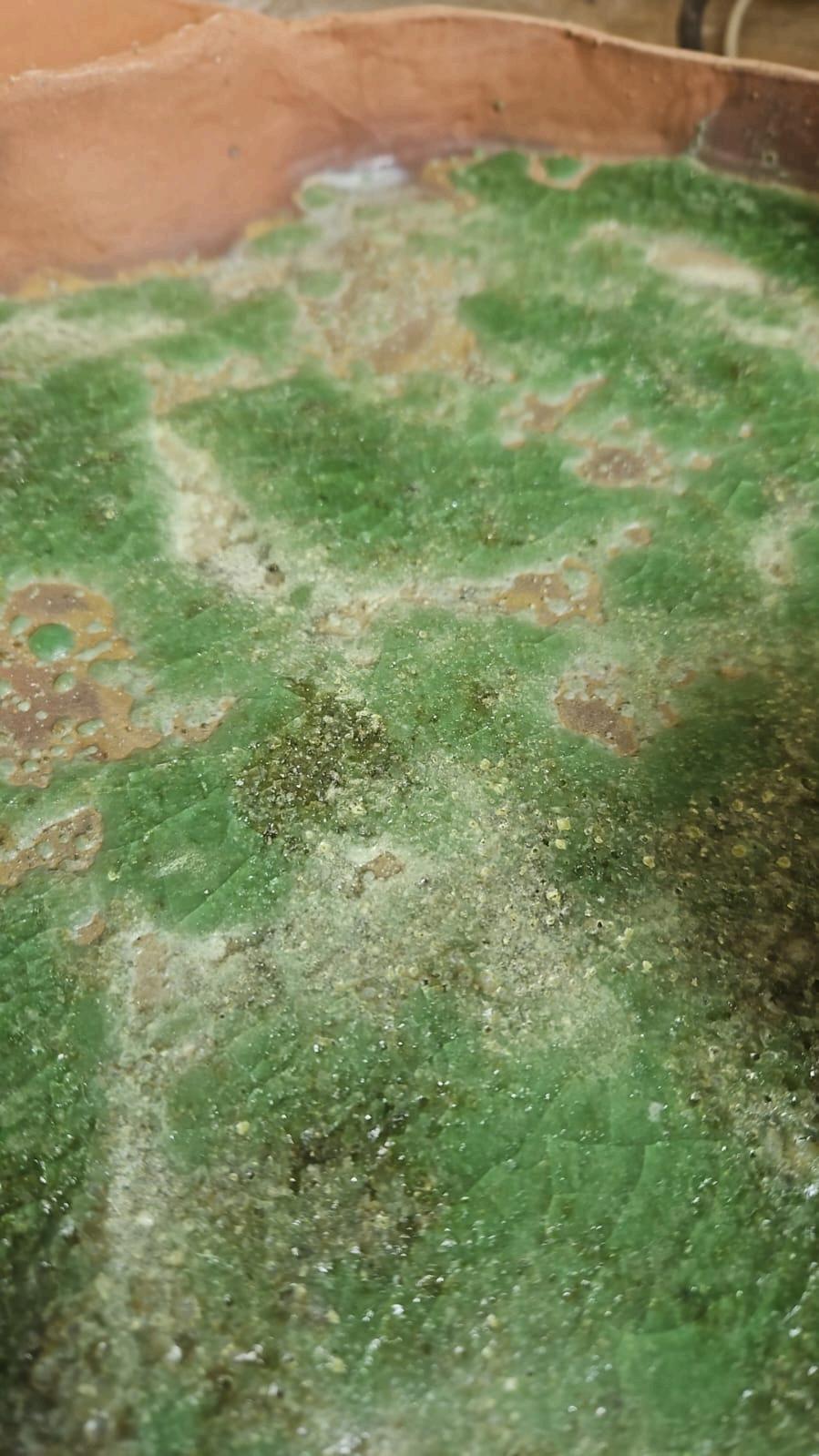Alevtina Lyapunova, Asya Marakulina, Bahareh Rahimi, Gloria Bergner, Julia Stakhorska, Lili Marie Theilen, Luisali Theisen, Maria Milagros Ainchil, Prima Mathawabhan, Tim Morris Schiffer and Zora Fuhrmann together with Kristin Weissenberger and Zahra Mirza
We are grateful for the 2024 Teaching Project Grant awarded by the Academy of Fine Arts, Vienna, which made it possible for us to explore important questions around waste and sustainability within artistic practice and ceramics. This support allowed us to dive deeper into these topics and pursue the project in a meaningful way.
We would also like to thank Prof. Michelle P. Howard and students from the Department of Architecture, who not only helped transport large amounts of clay to Kurzbauergasse, but also generously provided the material after it was removed from an installation they had created at Schillerplatz. Their decision to give the clay a second artistic life through our project was instrumental in allowing us to continue our exploration.
A big thanks goes out to our working group for their amazing contributions, our peers at Kurzbauergasse especially Johannes Hoffmann and Roland Kollnitz for support and our family and friends whose remote involvement through sharing reflections, feedback, and items they no longer needed—played a key role in helping us reclaim clay and experiment with natural materials, waste, and discarded objects. With everyone ’ s support, we were able to complete this teaching project and enrich our research.
Kristin Weissenberger and Zahra Mirza
In the one semester course of Ceramics 1, students were introduced to basic techniques using commercial tools, clay and glazes and then brought into discussions around topics of waste and sustainability within their art practice.
The title for the teaching project for Ceramics 1, “Waste is Optional: Between Artistic Agency and Gaze”, was inspired by and appropriated with permission from Outlander Materials* and their commitment to sustainable, compostable solutions. Ceramics 1 with Zahra Mirza and Natural Glazes Workshop with Kristin Weissenberger initiated a collaborative syndicate, evolving into a group of aspiring artistic researchers, learning and working together, experimenting with clay and sustainable materials to deepen their engagement with ceramics and sustainable art making practices.
Outlander Materials is based in BlueCity, a hub for circular entrepreneurs, in Rotterdam, The Netherlands.
G U E S T L E C T U R E S
We invited two guest speakers for workshops on expanded scope of sustainable ceramics and to address use of waste in their practice. Both guests actively engaged with students presenting them with their respective projects and how they push the boundaries of the medium both conceptually and technically.
The “Crush The Cup” workshop was a hybrid event led by Christina Schou Christensen, a ceramics artist and teacher at the Royal Danish Academy. Known for her focus on sustainable ceramics, Christina explored the use of clay, glazes, and the reuse of other materials. The workshop aimed to share ways how participants could create glazes from scratch using ceramics waste and local, non-commercial materials.
The “Record Keeping in Clay” workshop, led by Martin Kunze where he shared his innovative approaches to ceramics, particularly focusing on sustainable practices. Known for founding “Memory of Mankind,” a project capturing human history on color-printed ceramic tiles, and initiating CeraByte, which emphasizes eco-friendly data storage, Martin demonstrated how ceramics can be used for “record-keeping.” He guided participants through the ancient practice of making imprints, from fossils to cuneiform tablets, showcasing how everyday patterns can inspire the creation of ceramic objects.
E N C O U N T E R I N G C L A Y
The journey of the clay, sourced from the excavation of a tube station, adds another layer of depth to this narrative. This material, imbued with the history of urban development, was generously repurposed for the project for a second time. Previously, students of Architecture department at Schillerplatz had used it in its raw unpurified form for a temporary art d to the gs of tons of
The slow and demanding process of preparing the clay from immersion in water and blending to sifting and wedging was an experiential step into topics of sustainability and the intricate work required to rethink and recycle this material into a meaningful artistic and functional medium. Each stage of this preparation was a deliberate act, reflecting our commitment to understanding the complex relationship between waste and artistic practice, and considering the scope of integrating eco-conscious practices therein.
E X P E R I M E N T I
G W I T H C L A Y A N D G L A Z E W O R K S H O P
The summer workshop sessions were a critical phase of experimentation and problemsolving. We balanced artistic ambitions with practical constraints, addressing challenges such as glaze selection and health safety. There were many failures to achieve right balances and many negotiations towards preempting desired results. The choice of a foodsafe commercial glaze was a strategic decision to ensure the functional applicability of the pieces that could have potential use for eating or serving food. This exhibition thus serves as an interactive community event, a space where art and everyday life intersect, prompting visitors to engage with the materials on multiple levels visually, conceptually, and tactically.
Our exploration of waste, sustainability, and resource management extended beyond the artistic into the realm of practical impact. We scrutinized multiple aspects of our process, from the environmental impact of sourcing materials to the energy costs associated with their processing. Each decision was a negotiation between creative ambition and ecological responsibility and we know that we are far from claiming any ecological breakthrough . We faced the challenge of managing limited resources while striving for efficiency, reflecting our attempt to reducing our ecological footprint especially when it comes to sourcing raw and commercial materials for artistic production.


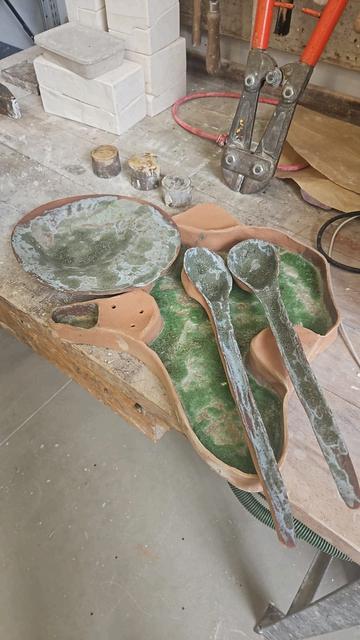
Our exploration of waste, sustainability, and resource management extended beyond the artistic into the realm of practical impact. We scrutinized multiple aspects of our process, from the environmental impact of sourcing materials to the energy costs associated with their processing. Each decision was a negotiation between creative ambition and ecological responsibility and we know that we are far from claiming any ecological breakthrough . We faced the challenge of managing limited resources while striving for efficiency, reflecting our attempt to reducing our ecological footprint especially when it comes to sourcing raw and commercial materials for artistic production.
C O L L E C T I
V E S C U L P T U R E
The outcome, a collective ceramic sculpture, conceived and developed collaboratively serves as a manifestation of shared artistic inquiry into the complex relationship between artmaking and ecological impact. From the outset, the project was less about achieving sustainability and more about exploring the tensions and contradictions that arise when artists engage with the materials of their practice. The reclaimed clay, sourced from Vienna's subway excavations, became a focal point for the group a medium that symbolized both the possibilities and limitations of working within environmental constraints.


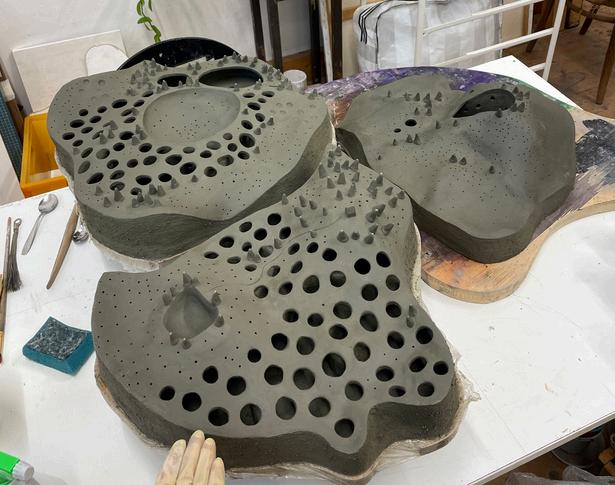

The development of the sculpture was a collective process, with each participant contributing not only to processing clay but also works that reflected their individual negotiation with the material. The concept was to create a topographical landscape of pieces that fit together like a puzzle, alluding to the emergence of sculpture as phenomenon that would not be possible without the collaboration taking place. Yet, it was not simply a matter of creating art from reclaimed clay; it was an evolving conversation among peers, questioning the assumptions that underlie our relationship to resources. As a group, we wrestled with the realization that sustainability, in the context of artistic practice, is often elusive. While the clay itself was repurposed, the tools, methods, and processes used to transform it were part of the same extractive systems the work sought to reconsider

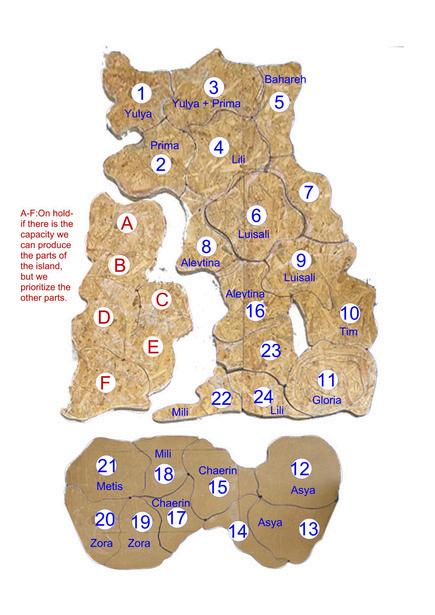
This shared creation was not driven by a desire to offer solutions or critique, but rather by a collective recognition of the complexities inherent in making art. The sculpture reflects this multiplicity of perspectives, each piece contributing to a larger topographical whole that mirrors the entangled, often contradictory, positions held by the artists. Together, they explored whether true sustainability is even possible in a field where materials are frequently sourced without full consideration of their environmental cost, questioning the role of the artist as both creator and consumer.
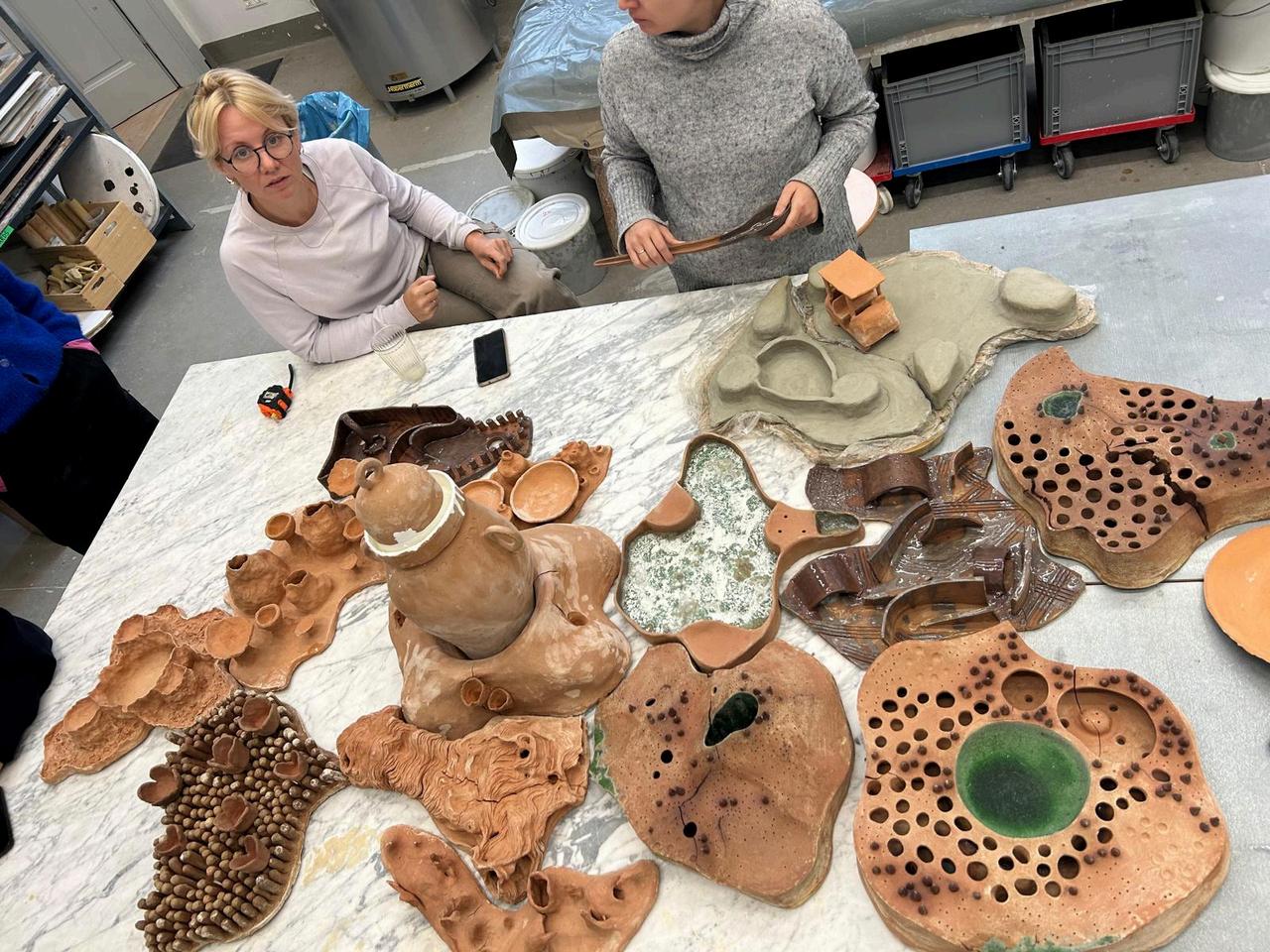
As a collective outcome, the sculpture embodies a peerdriven exchange, where each participant’s reflections on their own practice became intertwined with the group’s evolving dialogue. The work is less about the finished form and more about the process of inquiry an ongoing exploration of the roles and responsibilities of artists within broader ecological and industrial systems. Rather than offering clear-cut answers, the sculpture invites viewers into the conversation, reflecting the complexity and ambivalence that comes with attempting to navigate sustainability in contemporary art.
Exhibited with a finger food buffet as an open lunch event during The Sculpture Symposium, the display integrates art, community and sustainability in a shared space. The project encourages mindful engagement, inviting us to recognize our role in addressing sustainability challenges and positioning us as cocreators with natural systems.
O P E N Q U E S T I O N S
Towards the end of the course workshop and exhibition planning, students were presented with a list of questions and asked to answer one or more as a way of collecting and sharing feedback of the process they contributed to and developed together. This was also an exercise to identify and illustrate self reflective and critical gaps within practice, teaching and learning resources as well as ethical choices and think of improved strategies of expanding our engagement with sustainability
How did the origins of the clay influence your work, and what additional information would have been useful in understanding material origins?
Asya: I first started thinking about how clay differs from place to place each region has its own unique color and texture, and it changes color in a special way when fired. I began to reflect on how fascinating it is to work with local clay, with the local context, and to dig deeper by using the material itself as a conceptual element in any project.
Luisali: Discovering a new body of Clay is very fascinating. At the beginning you don't know how you can work with it, which temperature you can fire it or if it will resist the firing process at all. The original Clay in a raw state was gray but fired it became red or purple or deep chocolate brown depending on the temperature. So really every part of the clay is to be tested and discovered. It didn't take long, after starting to process the clay, to realize that it has a great plasticity and was very easily workable. I made a quite big Vase for this reason. I was fascinated by how fast and easy I could construct a tall and lean figure and I wanted to test out how far I could go.
Are there any invisible ethical or environmental issues that became apparent to you during the course and workshop?
Asya: Yes, I started noticing how often I didn’t think about where resources come from. If I needed clay, I would just go and buy it. During the workshop, I realized that sometimes materials can be found around us. And before just going to the store to buy something made in a chemical factory or somewhere else, about which I have no clue, I can make some materials myself, find them, for example, from discarded glass.
Luisali: I was very happy to have the opportunity to work with this local clay. It gives me the opportunity to create sculptures without having to buy imported materials packed in plastic and shipped around the world. I am also excited that now I know how to have a source of material I can find anywhere in the world and I don't have to spend anything to access it. Furthermore it gives me a material that enriches my practice with geologically and anthropology importance.
How did you balance artistic freedom with ethical practices, and what advice or resources would help manage this balance more effectively?
Asya: I believe that the idea and concept are much more important, and therefore, to express big ideas, you don’t necessarily need vast resources or lots of expensive, commercial materials. I always think of the Moscow conceptualists who lived in the closed USSR, where they had absolutely nothing except their texts and ideas, paper, simple pencils, and some everyday household items. Yet, they created brilliant works using minimal resources. In my own practice, I always try to start from the ideas or feelings I want to express, and I try to buy materials only when absolutely necessary, or if I can’t find them among those already existing or discarded by other artists. This helps me maintain some balance.
How did the information about tools, supplies and raw material sourcing affect your choices, and what additional insights would have been helpful? Did you find sourcing materials locally or online more effective for your practice?
Asya: In the past six months, I’ve been bringing back pieces of clay and stones from all my trips. I already have samples from Normandy, Iceland, and central France, and I’ve become very interested in seeing what results can be achieved using these local materials. For example, right now I’m working on a series using lava found in Iceland and clay from thermal springs. I’m trying to use it as glaze, and I find it much more intriguing than choosing glazes from a store if I can use the lava or clay directly from that place. It makes the works deeper and more interesting.
What difficulties did you experience in creating permanent works, and how might these challenges be addressed in future courses?
Asya: The challenges were mainly related to the fact that raw material is very different from the commercial clay I’m used to. Wild clay turned out to be completely unpredictable. It behaved very freely, with constant cracks and unexpected surprises. It was also very difficult to determine the melting point. Quite a few pieces made from wild Viennese clay were ruined. But at the same time, this negative experience showed me how important it is to embrace mistakes as well. It was also quite difficult to make tests without having my own kiln. I think when working with unprocessed, natural materials, it’s crucial to have your own kiln in order to run more tests.
Luisali: There are some difficulties ofcourse that come along with using these uncommercial materials. To really know it you have to do a lot of tests, which can be quite difficult. These tests have to be redone with every new source of clay that you find. Impurities could break your work in the firing process. For sure it is much easier to use commercial clay. But in my mind the way the wild clay shapes your work is so interesting that it is worth all the time you can spend on failed experiments and shattered cracked works.
In what ways did studio collaboration impact your work?
Asya: It was fascinating to observe how different people dealt with the challenges that arose because the material often resisted. To be honest, it was hard not to give in to that resistance and just give up altogether, because when one piece after another fails, it’s very demotivating, and you feel tempted to go back to the simple and familiar commercial clay. I was amazed that almost everyone managed to achieve some results. I don’t feel that the group had a significant influence on me. I was more interested in working with the clay. I was trying to understand how it behaves. And I’m satisfied with my result.
What role do you see for artists in addressing environmental and social issues, and how could the course better prepare students for this role?
Asya: I believe that artists or groups of artists are more like laboratories for shaping questions for society, raising various complex and controversial issues. These are laboratories where questions are formed, set, developed, and discussed. Unfortunately, I don’t think that artists alone can have a strong impact on ecological and social changes. It still mostly depends on corporations and major economic spheres of influence. Unfortunately, the world is deeply reliant on capitalist structures and economic decisions. If corporate leaders don’t consider the environmental or social situation, artists alone are unlikely to change this for the better. However, I believe that if these spheres aren’t separate but work in tandem, in collaboration, then perhaps this influence can be broadened and strengthened.
References and Links
https://sarahowardstudio.com/
https://ancientpottery com/
https://www unurgentargilla com/blog/how-to-process-wild-clay
https://ancientpottery how/courses/natural-pottery-paints-slips-and-pigments/ https://nativehands.co.uk/artist-maker/process/
https://www fortheloveofsoil org/
https://editorial ujaen es/libro/environment-workshops-2014-proccessing-ceramics-from-wastes-a-new-rawmaterial-source-for-a-global_55448/
https://www.beck-shop.de/martinez-garcia-bueno-dondi-processing-ceramics-waste-a-new-raw-material-source-fora-global-change/product/16421763
https://www kleistonestudio com/blogs/news/what-we-do-with-all-that-glaze-waste https://www sciencedirect com/science/article/abs/pii/S0959652620318722 https://ceramicartsnetwork.org/ceramics-monthly/ceramics-monthly-article/Clay-Culture-Zero-Waste https://materialdistrict com/article/ceramics-made-of-reclaimed-industrial-waste-by-products/ https://materialdistrict com/article/circular-tableware-recycled-porcelain/ https://www mdpi com/2075-163X/13/6/815
https://www.rozenthal.eu/post/recycling-in-ceramic-workshop https://ceramicsfieldguide.org/chapter-10/chapter-10-waste/ https://claymatters com au/Sink-Sludge https://drive google com/file/d/1WF9m3CvK4Lfok33dheicGCjlTFFISZsR/view https://www kesemydesign com/how-to-run-an-environmentally-responsible-ceramic-studio/ https://www.aucers.at/en/links
https://www mcl at/en/ https://www sciencedirect com/journal/materials-today https://www sciencedirect com/journal/ceramics-international https://www.youtube.com/watch?v=M6miZycAtk4&list=PLS6Mrdpt53RzyN8yqR1qfOXIYUrvcFp-7 https://www hfclay com/handouts
https://www mrgscience com/uploads/2/0/7/9/20796234/origin_of_life_sci_am pdf https://er educause edu/articles/2018/9/universal-design-for-learning-and-digital-accessibility-compatible-partnersor-a-conflicted-marriage
https://www geologie ac at/en/research-development/mapping/commodities/clay https://www bmf gv at/en/topics/mining/mining-in-austria/industrial-minerals html https://www world-mining-data info/ https://www.mindat.org/loc-434322.html
https://www clayly com/uk/#Books
https://vimeo com/ikavideo
https://new express adobe com/webpage/vPKaxNHwmj6ig https://www.goshen.edu/art/DeptPgs/Hazards.html#: :text=Dust%20from%20ordinary%20clay%20and,silicosis%20 if%20breathed%20often%20enough
https://www facebook.com/legacy/notes/10159555694449676/ https://glazy org/search?base_type=460&photo=true https://storeprojects.org/wp-content/uploads/2020/08/MakersManual9-EGGSHELLCERAMICS.pdf https://glazestuff wordpress com/category/egg-shell/https://juliannakunstler com/ceramics1 php https://juliannakunstler com/ceramics1 php https://www bloomsbury com/uk/colour-in-glazes-9781912217823/ https://livingdesign.info/ https://www.sciencedirect.com/science/article/abs/pii/S0959652617319182 https://www maxhetzler com/artists/rebecca-warren
